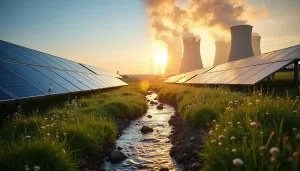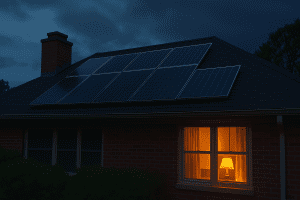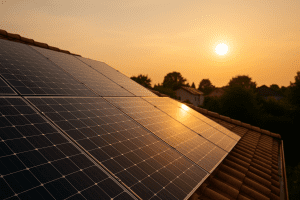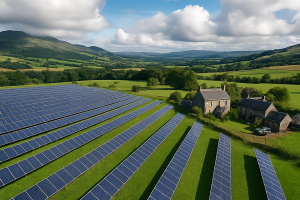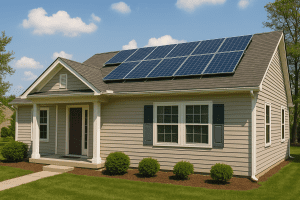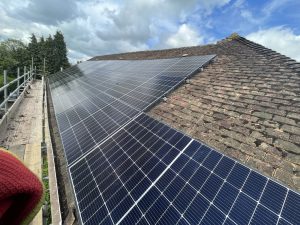The Hidden Environmental Advantages of Solar Energy: What Most People Don't Know

Written By
- Bhavna S4G
Published on
- 10 Jun 2025
The environmental advantages of solar energy go far beyond what most people expect. By switching to solar power, you not only reduce your electricity bills but also become part of a powerful environmental shift—cutting carbon emissions, conserving natural resources, and supporting a more sustainable future.
Your home running entirely on solar power equals the emission reduction of taking a car off the road for 19,316 miles each year. Solar power’s environmental benefits include massive water savings, as it saves up to 16,000 gallons of water per megawatt-hour compared to regular power plants. Solar panels create zero air pollution or greenhouse gasses while running, which leads to cleaner air in your neighborhood and surrounding areas.
The environmental impact of solar panels shows throughout their lifespan. These systems offset their production emissions in just one to three years, and they keep working well for 25-40 years. Since solar photovoltaic electricity costs have dropped by 82% since 2010, solar energy’s environmental advantages are more available than ever.
The environmental cost of traditional energy sources
Traditional energy sources carry huge environmental costs that most people don’t see in their daily lives. Let’s look at why we should think over alternative energy sources by understanding these effects.
Fossil fuel extraction and emissions
Fossil fuel extraction and burning places an environmental burden on our entire planet. These fuels substantially contribute to climate change. They make up more than 75% of global greenhouse gas emissions and about 90% of all carbon dioxide emissions. This massive carbon footprint has triggered over 300 natural disasters in a single year. These disasters affected more than 68 million people and led to economic losses of GBP 104.59 billion.
The numbers tell a stark story about how much carbon dioxide traditional energy sources produce per kilowatt-hour:
Coal: about 2.2 pounds of CO2 per kWh
Natural gas: about 0.9 pounds of CO2 per kWh
Oil: about 2.1 pounds of CO2 per kWh
Fossil fuel extraction ruins landscapes through strip mining, mountaintop removal, and drilling operations. Wildlife habitats break apart, surrounding environments become contaminated, and natural ecosystems change forever. Strip mining alone has destroyed over 500 mountaintops and buried more than 2,000 miles of streams in the Appalachian region.
Water usage in coal and nuclear plants
Traditional power generation needs enormous amounts of water. A single 1600 MWe nuclear unit uses about 90 cubic meters of water per second—that’s roughly 7.8 billion liters daily. Power generation ranks second only to agriculture as our country’s biggest water user.
These plants’ cooling needs create serious ecological issues. Hot water discharge into rivers and lakes raises water temperatures and hurts aquatic ecosystems. This heat pollution cuts dissolved oxygen levels and harms fish and other water creatures.
Water shortages during droughts or heat waves can force power plants to cut output or shut down. The Tennessee Valley Authority had to reduce its Browns Ferry units’ power in Alabama to 50% in 2010. They needed to keep river water temperatures below 32°C, which cost customers about GBP 39.71 million.
Air and soil pollution from power generation
Air pollution from burning fossil fuels creates a chain of environmental and health problems. These plants release sulfur dioxide, nitrogen oxides, particulate matter, mercury, and other harmful substances. Coal-fired plants release more sulfur dioxide than any other source, which leads to acid rain and breathing problems.
These emissions directly cause human suffering. Fossil fuel pollution kills one in five people globally, with about 6.7 million early deaths each year. Americans saw 350,000 early deaths in 2018 due to fossil fuel-related pollution.
Soil contamination poses another major challenge. Power plants’ coal ash contains toxic materials like arsenic, mercury, and lead. These poisons seep into soil and groundwater when not handled properly. They threaten both farming and drinking water supplies. Oil spills and fracking fluids also damage soil health and water quality in extraction areas.
The burden falls unevenly on different communities. Black and Hispanic Americans face 56 and 63 percent more particulate matter pollution than they create. This unfair distribution adds another layer to traditional energy sources’ real cost.
How solar energy changes the equation
Image Source: https://pixabay.com/
“Once you got a solar panel on a roof, energy is free. Once we convert our entire electricity grid to green and renewable energy, the cost of living goes down.” — Elizabeth May, Canadian politician and environmentalist
Solar power stands as a remarkable alternative to traditional energy sources and changes our environmental equation. Solar energy solves many environmental challenges that conventional power generation methods create.
Zero emissions during operation
The environmental advantage of solar energy is its zero-emission operation. Solar panels generate electricity without emitting greenhouse gasses or air pollutants, unlike fossil fuels that release harmful substances when burned. This clean process produces no direct carbon emissions, which makes solar energy one of today’s least carbon-intensive electricity generation methods.
Solar photovoltaic (PV) panels use semiconductors—mainly silicon, which is non-toxic—to convert sunlight directly into electricity. The direct conversion is more efficient than extracting energy from fossil fuels and eliminates combustion-related pollution. This brings a great improvement to communities worried about air quality, compared to traditional power plants that release sulfur dioxide, nitrogen oxides, and particulate matter.
No fuel extraction or combustion
A key benefit of solar energy to the environment lies in avoiding the destructive cycle of fuel extraction and combustion. Solar power needs no mining, drilling, fracking, or pipeline construction—activities that harm ecosystems and contaminate water supplies.
Solar energy helps protect natural landscapes and biodiversity. Traditional energy sources need extensive land disturbance to extract resources, while solar works well on existing structures or previously disturbed land. Solar installations don’t create waste products like coal ash that contains toxic substances leaching into soil and groundwater.
Solar’s minimal water usage adds another advantage. Traditional power plants use huge amounts of water to cool and operate, but solar PV systems run with almost no water. This water-saving feature reduces pressure on local water resources—especially in drought-prone areas.
Scalable for homes, businesses, and communities
The most practical environmental impact of solar energy comes from its adaptability. Solar systems work well for:
Residential rooftops providing power for single homes
Commercial installations meeting business energy needs
Community-scale projects serving multiple properties
Utility-scale solar farms generating power for thousands
This flexibility means solar energy meets different needs at any scale. Businesses can expand their solar installations as they grow, which helps maintain efficiency and reduce fossil fuel dependence.
Solar’s versatility goes beyond rooftop installations to innovative uses like floating solar arrays on water, agrivoltaics that combine farming with energy production, and solar carports serving multiple purposes. This adaptability lets solar blend into various environments with minimal disruption.
The planet needs to achieve net-zero emissions by 2050 under the Paris Agreement, which means solar capacity must grow 15-18 fold compared to 2022 levels. Solar technology keeps advancing with more efficient designs that expand possible applications and make solar central to our clean energy transition.
The environmental advantages of using solar energy make a strong case to switch. Solar power creates a sustainable future that benefits people and the planet through zero emissions during operation, no destructive fuel extraction, and adaptability across different applications.
Lesser-known environmental advantages of solar energy
Solar panels do more than just cut carbon emissions. They bring several environmental benefits that many people don’t notice. These advantages add much more ecological value than most of us realize.
Reduced water footprint
Water conservation stands out as one of the biggest environmental advantages of solar energy that people overlook. Regular power plants need huge amounts of water to cool down and generate steam. The average nationwide water consumption from grid electricity reaches 9.84 × 10^9 m3.
Solar photovoltaic systems need almost no water to generate electricity. The water savings make a big difference – households that switch to rooftop solar can cut their water use by 210%-1600%. The panels need just a quick clean now and then, which uses nowhere near the water that traditional power plants consume.
This benefit helps communities that don’t have enough water. Solar power works great even during droughts when traditional power plants might shut down because they can’t get enough cooling water.
No hazardous waste during use
Solar panels create clean electricity without producing harmful byproducts. Traditional energy systems constantly create waste streams, but solar offers a cleaner alternative.
The system’s design is simple – no complex pipes, boilers, or open flames needed. The risk of fires and environmental contamination drops by a lot because there’s no burning involved.
Solar panels last a long time too. Many manufacturers back their systems with warranties up to 50 years. This long life means you’ll throw away fewer parts and create less waste while the system runs.
Lower noise and visual pollution
Solar energy’s quiet operation sets it apart from other power sources. The panels turn sunlight into electricity through photovoltaic cells that have no moving parts.
Quiet power generation matters a lot to homes, schools, hospitals, and offices that need peace. Regular generators make noise between 65-90 decibels – loud enough to harm people who hear it too long.
Solar panels help block sound too. Put them in the right spots and they’ll absorb, reflect, and stop noise from factories and highways. Plants growing around solar installations make this sound barrier work even better, creating natural shields for nearby neighborhoods.
These hidden benefits show that solar energy’s environmental impact goes well beyond cutting carbon emissions.
Challenges and solutions in solar panel production
Solar power provides remarkable environmental benefits during operation, but manufacturing solar panels comes with several challenges. The industry keeps making great progress to address these issues through groundbreaking solutions.
Toxic byproducts and silicon waste
Solar panel production requires various materials that need careful handling. Silicon purification generates silicon tetrachloride—a toxic byproduct that can cause burns, air pollution, and release hydrochloric acid without proper disposal. The manufacturing process also uses chemicals like hydrofluoric acid, sodium hydroxide, and other etching agents. These pose risks to workers and the environment when not managed properly.
Water use in manufacturing
Water plays a vital role in solar panel production. Large gigafactories need millions of gallons daily for cleaning, cooling, etching, and processing crystalline and thin-film panels. Silicon’s purification process uses water extensively and remains a big challenge. Research shows manufacturing plants can cut water consumption by up to 79% with existing technologies like wastewater reuse and minimal liquid discharge approaches.
Improving efficiency and reducing material use
The solar industry keeps evolving toward eco-friendly practices despite these challenges. Recent innovations include:
Perovskite solar cells that could enable low-cost, low-temperature manufacturing while achieving efficiency rates of 25.2%
Better molecular arrangements that boost panels’ electrical charge separation
Anti-reflective coatings that can boost panel efficiency by 10.6%
These improvements reduce material consumption and maximize energy output, which creates a smaller environmental footprint for each unit of generated electricity.
Recycling initiatives and circular economy
The solar industry now adopts circular economy principles more widely. Solar panel waste could reach 78 million metric tons by 2050. Recycling programs focus on recovering valuable materials like silicon, silver, and aluminum from panels that reached end-of-life.
Many regions lack developed recycling infrastructure, but companies keep creating technologies to make solar panel recycling more economical. These circular strategies cut environmental impact and could recover materials worth $15 billion by 2050.
The future of solar: innovation and sustainability
Solar technology keeps expanding faster, and new developments promise to improve the environmental advantages of solar energy even more.
Next-gen solar technologies (e.g., perovskite)
Solar cell design leads renewable energy advancement. Perovskite solar cells could reshape how we capture sunlight. These cells are much thinner than traditional panels and offer flexibility and transparency. Lab tests show perovskites reaching efficiency rates above 33%. This is a big deal as it means they produce more electricity in less space—a significant environmental benefit of solar energy.
Tandem solar technologies combine perovskite layers with traditional silicon and show remarkable results. These hybrid cells capture different wavelengths of sunlight at once to maximize energy conversion. Such state-of-the-art developments could dramatically improve the environmental impact of solar energy by generating more power from existing surface area.
Floating solar and brownfield installations
Solar panels now work in surprising places. Floating photovoltaic systems on reservoirs and lakes provide unique benefits of solar panels. They reduce water evaporation and perform better through natural cooling. The right coverage could cut water evaporation by 15.3% to 55.2% in semiarid regions.
Brownfield installations turn contaminated or former industrial lands into clean energy producers. These sites, unsuitable for housing or agriculture, become productive while protecting pristine natural areas. This demonstrates more environmental advantages of using solar energy.
Policy support and public awareness
Technology alone can’t drive adoption. Strong policy support remains vital to speed up solar innovation. Countries that fund research and development well consistently lead solar technology breakthroughs.
Public awareness campaigns work alongside policy to expand solar adoption. Most potential users don’t know about community solar options or available technologies. Technology becomes more available each day, and education about the environmental benefits of solar energy helps more people switch to this sustainable power source.
Conclusion
The Path Forward: Welcome Solar for a Sustainable Future
Solar energy’s green benefits go way beyond what people first imagine. Without doubt, solar power stands as one of our best tools to fight climate change and protect our natural resources.
Old energy sources pale in comparison to solar power. Fossil fuels keep depleting resources, polluting our air and water, and warming our planet. Solar panels create clean electricity with zero emissions while running. Solar systems skip the destructive fuel extraction cycle, which helps preserve natural landscapes and biodiversity.
Solar energy lets you control your environmental footprint. Your choice to go solar helps reduce water use, cut harmful emissions, and build quieter, healthier communities. We have a long way to go, but we can build on this progress toward better production methods and recycling programs.
Solar’s future shines brighter than ever. New technologies promise better efficiency and flexibility. Solar installations on water bodies and cleaned-up lands show how adaptable this technology can be. Solar energy paves the way to a greener world.
Switching to solar power means more than just changing your energy source. It shows your steadfast dedication to protecting our environment for future generations. Solar enables you to make real change now instead of waiting for others to fix our environmental problems. The green benefits start right away and last long term, creating a sustainable legacy beyond your home.
We should not question if solar makes environmental sense anymore. The real question is how fast we can use this clean, renewable resource to build the sustainable future our planet needs.
FAQs
Q1. How does solar energy compare to traditional power sources in terms of environmental impact? Solar energy has a significantly lower environmental impact compared to traditional power sources. Unlike fossil fuels, solar panels produce zero emissions during operation, don’t require fuel extraction or combustion, and use minimal water. This results in reduced air and water pollution, lower greenhouse gas emissions, and less disruption to natural ecosystems.
Q2. What are some lesser-known environmental benefits of solar panels? Some lesser-known benefits include substantial water conservation, as solar panels require very little water compared to traditional power plants. They also produce no hazardous waste during operation and contribute to lower noise pollution due to their silent electricity generation process.
Q3. How are manufacturers addressing the environmental challenges of solar panel production? The solar industry is actively working to improve manufacturing processes by developing more efficient technologies, reducing material use, and implementing recycling initiatives. Innovations like perovskite solar cells and improved molecular arrangements are increasing panel efficiency while decreasing resource consumption. Additionally, circular economy principles are being adopted to recycle end-of-life panels and recover valuable materials.
Q4. Can solar energy help in water conservation? Yes, solar energy significantly contributes to water conservation. Unlike traditional power plants that require large amounts of water for cooling, solar panels operate with minimal water needs. This can lead to substantial water savings, especially in drought-prone regions. Some estimates suggest that households can reduce their water consumption by 210%-1600% when switching to rooftop solar.
Q5. What innovations are shaping the future of solar energy? The future of solar energy is being shaped by several innovations. These include next-generation technologies like perovskite solar cells, which offer higher efficiency and flexibility. Tandem solar technologies combining different materials are also showing promise. Additionally, novel applications such as floating solar installations on water bodies and the use of brownfield sites for solar farms are expanding the potential for solar energy deployment.

